
Published 14-02-2025
Keywords
- Retro-Mediation,
- Radical-Mediation,
- Pre-Mediation,
- Dystopia,
- Social Imaginary
- Visual Cultures ...More

This work is licensed under a Creative Commons Attribution-NonCommercial-NoDerivatives 4.0 International License.
Abstract
The paper starts from a twofold observation. Firstly, as a “total social fact” (Mauss, 2016), COVID-19 has redefined crucial moments of individual and collective life (birth, marriage, death, etc.) and every dimension of human activity (economy, politics, culture). Secondly, the pandemic imposed a new iconography based on identifiable objects and practices (masks, disinfectant gels, supermarket queues, vaccine syringes, etc.) (Mitchell, 2017; Pintor Iranzo, 2020). In some ways, a reversal of dystopian narratives, literary and audiovisual of previous decades seem to many. Therefore, we intend to reflect on ‘retro-mediation’ as a new logic of remediation of past (audio)visual cultures fuelled by the feeling of living in a dystopian present. This logic directly connects with Richard Grusin’s ‘pre-mediation’ (Grusin, 2004; 2010) processes. On the one hand, retro-mediation is shaped by the forces of pre-mediation, which, by simultaneously containing and fuelling anxiety about the pandemic management, foster emotional alertness and constant familiarity with the visual cultures of the virus. On the other hand, retro-media logics are defined by the virus’ ability to affect our imagination since our bodies – authentic biological media – become the ‘mediators’ of contagion and, therefore, central factors in the re-imagination of the past. Thus, retro-mediation will be analysed as a media logic of re-imagining the past, which – in the wake of the reversal of dystopia in the present – takes the form of retroactive remediation through which users project symbols, icons, and dystopian elements, drawn from pandemic visual culture, onto the audiovisual images of the pre-COVID-19 years. The examples examined, taken from the TV series The Big Bang Theory, POSE, The Handmaid’s Tale, and Pushing Daisies, will highlight the sociocultural mechanisms brought into play by retro-mediation, capable of conditioning the forms of production, reproduction, and reconversion of social imaginaries (Marzo & Meo, 2019).
